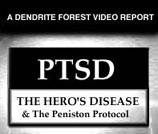
Brief presentations of information on
aspects of PTSD:
- PTSD and Community Violence
- PTSD in Children
- PTSD and Problems with
Alcohol Use
- PTSD and Relationships
- PTSD and the Family
- Physical Health and
PTSD
- Survivors of Natural
Disasters
- Epdimological Facts About
PTSD --How
many people exposed to traumatic events have PTSD?
- Disaster and Rescue
Workers and PTSD
- Warning
Signs
Warning signs of trauma-related stress, from Los Angeles County Department of Mental Health.
- Warning
Signs from APA
Warning signs of trauma-related stress, from the American Psychological Assn.
- Victim Emotional Health
Emotional health issues for victims, from the American Red Cross.
- Coping
Suggestions
Coping suggestions, from Los Angeles County Department of Mental Health.
- Normalizing
Emotions
You are not alone! description of normal emotions following a disaster, from the American Red Cross.
-
Post-Traumatic Stress Disorder: An Overview" Matthew J. Friedman
The
Peniston Protocol
PTSD Treatment
VA NATIONAL
CENTER FOR PTSD
Research and Education on Post-Traumatic
Stress Disorder
FACTS
ABOUT PTSD
A National Center
Fact Sheet
What causes post-traumatic stress disorder? How common is it? Who gets it?
These questions are asked by epidemiologists, and two major epidemiological studies have produced some answers.
- The National Vietnam Veterans Readjustment Survey
(NVVRS), conducted between November 1986 and February 1988, interviewed
3,016 American veterans selected to to provide a representative sample
of those who served in the armed forces during the Vietnam era.
- The National Comorbidity Survey (NCS), conducted between September 1990 and February 1992, interviewed a representative national sample of 8,098 Americans aged 15 to 54 years.
The following information on PTSD in the general adult population is taken from the NCS report
The estimated lifetime prevalence of PTSD among adult Americans is 7.8%, with women (10.4%) twice as likely as men (5%) to have PTSD at some point in their lives. This represents a small proportion of those who have experienced a traumatic event at some point in their lives, for 60.7% of men and 51.2% of women reported at least one traumatic event. The most frequently experienced traumas were
- witnessing someone being badly injured or killed
- being involved in a fire, flood, or natural disaster
- being involved in a life-threatening accident
- combat exposure
The majority of these people experienced two or more types of trauma. More than 10% of men and 6% of women reported four or more types of trauma during their lifetimes.
The traumatic events most often associated with PTSD were:
- for men: rape, combat exposure, childhood neglect, and childhood physical abuse
- for women: rape, sexual molestation, physical attack,
being threatened with a weapon, and childhood physical abuse
But none of these events invariably produced PTSD in those
exposed to it, and a particular type of traumatic event does not necessarily
affect different sectors of the population in the same way.
The NCS report concluded that "PTSD is a highly prevalent lifetime disorder that often persists for years. The qualifying events for PTSD are also common, with many respondents reporting the occurrence of quite a few such events during their lifetimes."
The following information on PTSD among Vietnam War veterans is taken from the NVVRS report:
The estimated lifetime prevalence of PTSD among American Vietnam theater veterans is 30.9% for men and 26.9% for women. An additional 22.5% of men and 21.2% of women have had partial PTSD at some point in their lives. Thus more than half of all male Vietnam veterans and almost half of all female Vietnam veterans -- About 1,700,000 Vietnam veterans in all -- have experienced "clinically serious stress reaction symptoms."
15.2% of all male Vietnam theater veterans (479,000 out of 3,140,000 men who served in Vietnam) and 8.1% of all female Vietnam theater veterans (610 out of 7,200 women who served in Vietnam) are current cases of PTSD. ["Current" means 1986-88 when the Survey was conducted.]
The NVVRS report also contains these figures on other problems of Vietnam veterans:
40% of Vietnam theater veteran men have been divorced at least once (10% had two or more divorces), 14.1% report high levels of martial problems, and 23.1% have high levels of parental problems.
Almost half [of male Vietnam theater veterans currently suffering from PTSD] had been arrested or in jail at least once -- 34.2% more than once -- and 11.5% had been convicted of a felony.
The estimated lifetime prevalence of alcohol abuse or dependence among male theater veterans is 39.2%, and the estimate for current alcohol abuse or dependence is 11.2%. The estimated lifetime prevalence of drug abuse or dependence among male theater veterans is 5.7%, and the estimate for current drug abuse or dependence is 1.8%.
Because the NVVRS sample size underrepresented members of certain ethnic minorities, the Matsunaga Vietnam Veterans Project undertook further epidemiological research among Native American, Asian American, and Pacific Islander veterans. These findings are summarized in a separate National Center factsheet.
THIS FACT SHEET WAS BASED ON
- Richard A. Kulka (et al), Trauma and the Vietnam War Generation:
Report of Findings from the National Vietnam Veterans Readjustment Study
(New York: Brunner/Mazel, 1990; ISBN 0-87630-573-7)
- Ronald C. Kessler (et al), "Posttraumatic Stress Disorder in
the National Comorbidity Survey," Archives of General Psychiatry
52(12): 1048-1060 (December 1995)
